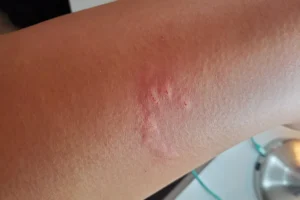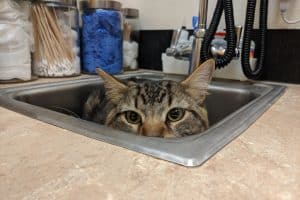Note: We may earn a commission from helpful, relevant links in our content. No cost to you. See our privacy policy.
Cats use their claws to climb, escape, defend themselves, stretch and exercise, and even communicate by scratch marks. So what happens when you cut them off? Can you replace them with fake claws?
Unfortunately, there are no such things as fake or prosthetic claws. Declawing a cat means more than just removing the claws – they also remove the tendons, preventing the claws from growing back. There is no way to repair it, let alone add artificial claws.
This article explores why there are no prosthetic cat claws, whether claws can regrow (be reversed), and how to care for an already declawed cat.

Do Prosthetic Cat Claws Exist?
To declaw a cat, a veterinarian will cut off the tips of all the toes because claws grow from them. This means that the artificial cat claws would have to function as both toes and claws, which would be extremely difficult to create.
Some cat owners, in a bid to help their declawed pets, have considered 3D-printed solutions. However, the complexity of the cat’s anatomy makes it currently impractical.
Declawing a cat is anatomically equivalent to removing the entire last bone in the joint of a human finger. During declawing, the tips of a cat’s toes are also severed, which is why you should never attempt to do it yourself.
Even if a surgeon were to reattach the cat’s toe tips, the tendons that control the claws would not function properly. Furthermore, even if the tips could be reattached, it is unlikely that the vet who performed the declawing saved them and kept them on ice.
Moreover, the delicate biomechanics of a cat’s paws, encompassing balance and movement, make it a formidable challenge to replicate with any artificial solution.
It’s usually a done deal if your cat has been declawed. You can now take extra precautions and educate yourself on the effects of declawing, but you cannot replace the cat claws with prosthetic ones.
While some cat owners use claw caps on their cats, these only work if your cat already has claws, so they will only work on a cat with untouched claws. They are also temporary and will naturally fall off after a few weeks as the nail sheds.
Can Declawed Cats Regrow Their Claws?
A cat’s claws cannot regrow after surgery. However, sometimes the surgery isn’t properly done, and the claws may regrow in pain, necessitating corrective surgery.
One common misconception is that declawing is like trimming nails. In reality, the surgical removal is permanent, and there’s no existing technology that fully replicates a cat’s natural clawing mechanism.
Claw regrowth occurs due to incomplete removal of the ungual crest and can cause abscess formation and pain. Claw regrowth occurs in approximately 3% of declawed cats. Furthermore, any signs of limping, redness, or swelling in a declawed cat’s paw should be immediately addressed with a veterinarian.

Is It Possible to Reverse Declawing?
There’s no known way to restore a cat’s claw or reverse the declawing process. You’d have to transplant the end of the digit onto the cat, which isn’t worth further damaging her feet.
While a surgical procedure can relieve the chronic pain caused by a cat’s declawing, it does not replace the claws. It may, however, aid in pain management and allow the cat to walk, run, and jump naturally.
If her paws hurt, there’s not much you can do except give her soft surfaces to walk on and remember to protect their feet with the helpful tips listed below.
What to Do if Your Cat Was Already Declawed?
If the cat has recently been declawed, consider replacing their cat litter with shredded newspaper to prevent sand from getting into their wounds, as this could result in an infection.
Most declawed cats prefer the soft litter to clumping clay litter on their paws. Some declawed cats prefer fine-tuned litter over chunky litter because it can hurt their paws.
A declawed cat may experience pain when walking on rocks or sand grains, so try to keep them off these surfaces. Furthermore, do not encourage them to jump until their paws have healed, and do not allow them to go outside again.
Just like with a fully clawed cat, make sure you don’t let them play with your hands. That will only encourage them to bite more. You should provide them with plenty of playtimes with toys that are now appropriate for them.
Wand toys, particularly those that float through the air, are excellent for declawed cats. Most of the time, these toys are more about the chase and the hunt than catching them, so they don’t need claws.
If the cat is only front-declawed, she might enjoy kicker toys that allow her to use her feet. Some of the better ones include Jackson Galaxy’s Ultimate Bunny Kicker.
Keep an eye on your cat if they have been declawed. Everything is fine if they can walk, run, and play nicely.
FAQs
Do vets still declaw cats?
Some veterinarians still declaw cats as a last resort to keep them from being re-homed or euthanized or to treat an infection. Declawing has fallen out of favor in recent decades, and even the American Veterinary Medical Association (AVMA) advises against it.
Are declawed cats happy?
Typically, if declawing was done properly on a kitten, and there were no later complications or claw regrowth, a cat may still be happy. Other times, adult cats develop pain issues and even arthritis later in life, making them less comfortable.
Can cats’ claws be extended?
A cat can extend their claws on one or more paws voluntarily. You can extend your cat’s claws by gently pressing the top and bottom of its paw. Cats naturally shred their claws, and owners trim them to prevent growing too large, curling and causing an infection.
Alex, a passionate animal lover, has experience in training and understanding animal behavior. As a proud pet parent to two dogs and three cats, he founded AnimalReport.net to share insights from animal experts and expand his knowledge of the animal kingdom.









